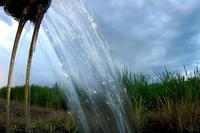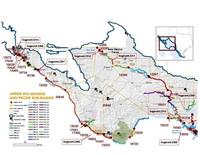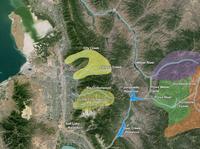-
World's shrinking groundwater sources in urgent need of better governance

Groundwater makes up 97 per cent of the world’s available fresh water. Total global use is estimated by scientists at around 1,000 cubic kilometers a year, with the largest users being India, China, and the United States. Since 1900, the world has drawn down its groundwater reserves by an estimated 4,500 cubic kilometers — and demand continues to increase, especially in arid countries, which are rapidly running short of water that can be affordably extracted. Scientist has urged the world to take better care of its groundwater resources — or risk dangerous scarcities, economic impacts, and potential conflicts in coming decades.
-
-
Upper Rio Grande to experience growing gap between water supply and demand

Increasing temperatures and changes in the timing of snowmelt runoff could impact the amount of water available on the upper Rio Grande in the future, says a news study. Temperatures will increase four to six degrees Fahrenheit by the end of the twenty-first century, according to the climate modeling used in the study. Although the modeling projects that total annual average precipitation in the basin will not change considerably, we are likely to see a decreasing snowpack, an earlier and smaller spring snowmelt runoff and an increase in the frequency, intensity and duration of both droughts and floods.
-
-
Seeds from Moringa oleifera trees better then chemicals for purifying water
Clean water is essential for good health. In many countries it is still difficult to obtain clean water. Even developed countries can benefit from a process that treats waste water without addition of further synthetic chemicals. Seeds from Moringa oleifera trees can be used to purify water. Researchers have discovered that seed material can offer a more efficient purification process than conventional synthetic materials in use today.
-
-
New catalyst for cleanup of nitrites
Nitrites and their more abundant cousins, nitrates, are inorganic compounds that are often found in both groundwater and surface water — a big problem, particularly for agricultural communities. The compounds are a health hazard, and the EPA places strict limits on the amount of nitrates and nitrites in drinking water. While it is possible to remove nitrates and nitrites from water with filters and resins, the process can be prohibitively expensive. Chemical engineers at Rice University have found a new catalyst that can rapidly break down nitrites.
-
-
Rising temperatures threaten Salt Lake City’s water supply

In an example of the challenges water-strapped Western cities will face in a warming world, new research shows that every degree Fahrenheit of warming in the Salt Lake City region could mean a 1.8 to 6.5 percent drop in the annual flow of streams that provide water to the city. By midcentury, warming Western temperatures may mean that some of the creeks and streams that help slake Salt Lake City’s thirst will dry up several weeks earlier in the summer and fall.
-
-
Aquifer supplying a third of U.S. irrigated groundwater depleting quickly: study
The High Plains Aquifer of Kansas — also called the Ogallala Aquifer — supplies 30 percent of the U.S. irrigated groundwater. New study finds that if current irrigation trends continue, 69 percent of the groundwater stored in the High Plains Aquifer will be depleted in fifty years.
-
-
Bacteria to clean contaminated leftover water used in fracking

Fracking is a drilling technique which uses lots of water — up to 5-7 million gallons per frack. One well may be fracked several times. The water goes in clean and comes out contaminated with organic substances that render it unfit for reuse. Purifying that water would reduce the pressure on waste disposal sites called injection wells, as well as on sites of wastewater spills. Researchers say that bacteria may someday clean leftover frack water.
-
-
Analysts: arrogance, clumsiness of oil and gas industry caused fracking’s bad image
Oil and gas industry experts say arrogance, secrecy, and poor communication by the drilling industry have led to public anger over hydraulic fracturing, or fracking. These experts are calling for fracking companies to release more information to alleviate public concerns about the relationship between the drilling technology and water contamination.
-
-
Well water contaminants highest near natural gas drilling: study
A new study of 100 private water wells in and near the Barnett Shale showed elevated levels of potential contaminants such as arsenic and selenium closest to natural gas extraction sites. Researchers believe the increased presence of metals could be due to a variety of factors including: industrial accidents such as faulty gas well casings; mechanical vibrations from natural gas drilling activity disturbing particles in neglected water well equipment; or the lowering of water tables through drought or the removal of water used for the hydraulic fracturing process. Any of these scenarios could release dangerous compounds into shallow groundwater.
-
-
U.K. water industry: fracking may contaminate U.K. drinking water
U.K. water companies have warned the shale gas industry that the quality of U.K. drinking water must be protected at all costs and fracking must not harm public health. Shale gas fracking could lead to contamination of the water supply with methane gas and harmful chemicals if not carefully planned and carried out.
-
-
Reinvestment in U.S. water infrastructure should be a top national priority
The U.S. water infrastructure is often called the “invisible infrastructure” – a vast, largely invisible network of pipes and tunnels — nearly 1.4 million miles span across the United States, which is eight times the length of the U.S. highway system. Much of the U.S. infrastructure was built more than a century ago, and currently around 10 percent of these systems are at the end of their service life. If not addressed by 2020, this number could rise to 44 percent. A summit meeting of the U.S. water community calls on Congress to make water infrastructure a top national priority.
-
-
Interior Dept. releases progress report on U.S. Water Census
The U.S. Interior Department issued released a report to Congress on the progress of the National Water Census. As competition for water grows — for irrigation of crops, for use by cities and communities, for energy production, and for the environment — the need for the National Water Census and related information and tools to aid water resource managers also grows. The Water Census will assist water and resource managers in understanding and quantifying water supply and demand, and will support more sustainable management of water resources.
-
-
Water treatment plant ozone upgrade wins civil engineering award
The Ozone Upgrade and Expansion Project of the Alvarado Water Treatment Plant in San Diego, California, was named the winner of the American Society of Civil Engineers (ASCE) 2013 Outstanding Civil Engineering Achievement (OCEA) Award. In addition to expanding plant capacity by 67 percent, the city of San Diego converted from chlorine to ozone disinfection. The incorporation of ozone enabled the city to provide not only safer water with lower levels of carcinogenic disinfection by-products, but also water that is odorless and better tasting.
-
-
Water security experts at U Arizona annual conference
How can Arizona secure a safe, sustainable water supply for its current and future residents? The University of Arizona Water Resources Research Center will take on this complex issue at its annual conference on 5 March.
-
-
Georgia wants to redraw its northern border to tap Tennessee River water
Lawmakers in Georgia are renewing efforts to claim Georgia’s right to tap into the Tennessee River’s water supply. The lawmakers hope to achieve this by raising questions about the exact demarcation of the border between the two states.
-
- All
- Regional
- Water
- Biometrics
- Borders/Immig
- Business
- Cybersecurity
- Detection
- Disasters
- Government
- Infrastructure
- International
- Public health
- Public Safety
- Communication interoperabillity
- Emergency services
- Emergency medical services
- Fire
- First response
- IEDs
- Law Enforcement
- Law Enforcement Technology
- Military technology
- Nonlethal weapons
- Nuclear weapons
- Personal protection equipment
- Police
- Notification /alert systems
- Situational awareness
- Weapons systems
- Sci-Tech
- Sector Reports
- Surveillance
- Transportation
Advertising & Marketing: advertise@newswirepubs.com
Editorial: editor@newswirepubs.com
General: info@newswirepubs.com
2010-2011 © News Wire Publications, LLC News Wire Publications, LLC
220 Old Country Road | Suite 200 | Mineola | New York | 11501
Permissions and Policies
Editorial: editor@newswirepubs.com
General: info@newswirepubs.com
2010-2011 © News Wire Publications, LLC News Wire Publications, LLC
220 Old Country Road | Suite 200 | Mineola | New York | 11501
Permissions and Policies
